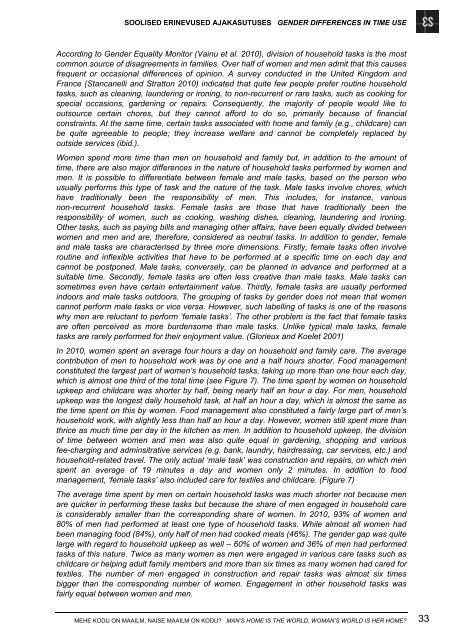MEHE KODU ON MAAILM, NAISE MAAILM ON KODU? - Tartu Ãlikool
MEHE KODU ON MAAILM, NAISE MAAILM ON KODU? - Tartu Ãlikool
MEHE KODU ON MAAILM, NAISE MAAILM ON KODU? - Tartu Ãlikool
Create successful ePaper yourself
Turn your PDF publications into a flip-book with our unique Google optimized e-Paper software.
SOOLISED ERINEVUSED AJAKASUTUSES GENDER DIFFERENCES IN TIME USE<br />
According to Gender Equality Monitor (Vainu et al. 2010), division of household tasks is the most<br />
common source of disagreements in families. Over half of women and men admit that this causes<br />
frequent or occasional differences of opinion. A survey conducted in the United Kingdom and<br />
France (Stancanelli and Stratton 2010) indicated that quite few people prefer routine household<br />
tasks, such as cleaning, laundering or ironing, to non-recurrent or rare tasks, such as cooking for<br />
special occasions, gardening or repairs. Consequently, the majority of people would like to<br />
outsource certain chores, but they cannot afford to do so, primarily because of financial<br />
constraints. At the same time, certain tasks associated with home and family (e.g., childcare) can<br />
be quite agreeable to people; they increase welfare and cannot be completely replaced by<br />
outside services (ibid.).<br />
Women spend more time than men on household and family but, in addition to the amount of<br />
time, there are also major differences in the nature of household tasks performed by women and<br />
men. It is possible to differentiate between female and male tasks, based on the person who<br />
usually performs this type of task and the nature of the task. Male tasks involve chores, which<br />
have traditionally been the responsibility of men. This includes, for instance, various<br />
non-recurrent household tasks. Female tasks are those that have traditionally been the<br />
responsibility of women, such as cooking, washing dishes, cleaning, laundering and ironing.<br />
Other tasks, such as paying bills and managing other affairs, have been equally divided between<br />
women and men and are, therefore, considered as neutral tasks. In addition to gender, female<br />
and male tasks are characterised by three more dimensions. Firstly, female tasks often involve<br />
routine and inflexible activities that have to be performed at a specific time on each day and<br />
cannot be postponed. Male tasks, conversely, can be planned in advance and performed at a<br />
suitable time. Secondly, female tasks are often less creative than male tasks. Male tasks can<br />
sometimes even have certain entertainment value. Thirdly, female tasks are usually performed<br />
indoors and male tasks outdoors. The grouping of tasks by gender does not mean that women<br />
cannot perform male tasks or vice versa. However, such labelling of tasks is one of the reasons<br />
why men are reluctant to perform ‘female tasks’. The other problem is the fact that female tasks<br />
are often perceived as more burdensome than male tasks. Unlike typical male tasks, female<br />
tasks are rarely performed for their enjoyment value. (Glorieux and Koelet 2001)<br />
In 2010, women spent an average four hours a day on household and family care. The average<br />
contribution of men to household work was by one and a half hours shorter. Food management<br />
constituted the largest part of women’s household tasks, taking up more than one hour each day,<br />
which is almost one third of the total time (see Figure 7). The time spent by women on household<br />
upkeep and childcare was shorter by half, being nearly half an hour a day. For men, household<br />
upkeep was the longest daily household task, at half an hour a day, which is almost the same as<br />
the time spent on this by women. Food management also constituted a fairly large part of men’s<br />
household work, with slightly less than half an hour a day. However, women still spent more than<br />
thrice as much time per day in the kitchen as men. In addition to household upkeep, the division<br />
of time between women and men was also quite equal in gardening, shopping and various<br />
fee-charging and adminsitrative services (e.g. bank, laundry, hairdressing, car services, etc.) and<br />
household-related travel. The only actual ‘male task’ was construction and repairs, on which men<br />
spent an average of 19 minutes a day and women only 2 minutes. In addition to food<br />
management, ‘female tasks’ also included care for textiles and childcare. (Figure 7)<br />
The average time spent by men on certain household tasks was much shorter not because men<br />
are quicker in performing these tasks but because the share of men engaged in household care<br />
is considerably smaller than the corresponding share of women. In 2010, 93% of women and<br />
80% of men had performed at least one type of household tasks. While almost all women had<br />
been managing food (84%), only half of men had cooked meals (46%). The gender gap was quite<br />
large with regard to household upkeep as well – 60% of women and 36% of men had performed<br />
tasks of this nature. Twice as many women as men were engaged in various care tasks such as<br />
childcare or helping adult family members and more than six times as many women had cared for<br />
textiles. The number of men engaged in construction and repair tasks was almost six times<br />
bigger than the corresponding number of women. Engagement in other household tasks was<br />
fairly equal between women and men.<br />
<strong>MEHE</strong> <strong>KODU</strong> <strong>ON</strong> <strong>MAAILM</strong>, <strong>NAISE</strong> <strong>MAAILM</strong> <strong>ON</strong> <strong>KODU</strong>? MAN’S HOME IS THE WORLD, WOMAN’S WORLD IS HER HOME? 33

















